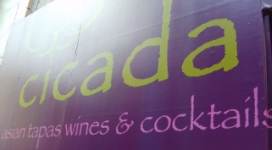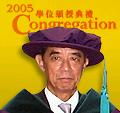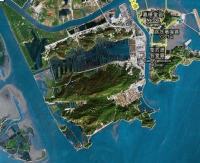26 October-1 November, 2008
Another week, another great moment in strong, executive-led government, as our valiant Chief Executive Donald Tsang reverses his insistence that an increase in Old Age Allowance should go only to poorer old folk. The original proposal – to increase the universal monthly HK$750 ‘fruit money’ for means-tested over-70s – was surely devised by an official with a secret desire to see the administration attacked by every political party, every noisy huddle of activists, every newspaper and of course every crotchety, gray-haired old granny in town. “How dare this brute show such disrespect for our cherished elderly?” they shrieked in unison.
What the Government could have said is, “We can raise the hand-out to HK$850 and keep it universal, or we can make it HK$1,500 and target it at the proportion of the elderly who are genuinely impoverished and pick through garbage all day and give tourists a bad impression. Which would you, the great Hong Kong public, prefer?” But they didn’t. They could have made the point that a subsidy for better-off senior citizens must come at the expense of relatively hard-up taxpayers or younger welfare recipients. “It would be a transfer of wealth from the poor to the rich!” our leaders could have protested, shocked at the very thought that such a thing could happen in the Big Lychee. But again, they didn’t.
The only argument the bureaucrats had the wits to think up was based on the tired old 1970s colonial principle that recurrent expenditure on anything apart from rat poison, civil service remuneration and the cops is dangerous and evil. Hong Kong, in this mind-set, has a rootless, uneducated population who expect nothing but what they can acquire from their own hard work. Social spending will just lure more starving peasants from over the border and for the wrong reasons. Public expenditure to make the place pleasant for the general populace in any way is an unthinkable burden and waste. “The cost of fruit money will go up to HK$14 billion in 25 years if there is no means test,” warned the Government.
Sir Bow-Tie pinned a big sign on his backside saying ‘Kick me’, and so everyone did. Then, after some hasty, behind-the-scenes freaking out with his most trusted advisors nodding obediently to his squeals about irrational public debate, he backtracked 100%. This, he claimed, was in the interests of harmony. Predictably, sprightly 65- to 70-year-olds in training to become full-fledged, Hong Kong-style, Oldies from Hell now demand that means-testing be abolished for them. People with some basic understanding of fiscal policy – or, indeed, just elementary politics – look on in disbelief at this embarrassing climb-down by feeble, expediency-driven wimps and ponder the precedent it sets for such forthcoming excitements as a minimum wage, health-care financing and tax reform.
And everyone asks a simple question. Our top officials originally said a hike in the Allowance without means-testing was, essentially, not possible. Now they are saying it is. There are three possibilities. One – they were lying first time round. Two – they were being stupid the first time round. And three… No, there are just two possibilities.
Either I’m mad or everyone else is. I bought some HSBC yesterday at below HK$80, some Swire trading at under half its net asset value and some Manulife at over 60% less than it was a year ago. I will now avert my gaze while they continue evaporating into nothing, and picture myself boring people in five years’ time about my prescience and cast-iron stomach.
Although their price trend suggests imminent liquidation, none of these well-managed blue-chip companies has actually shut its doors yet. Which is more than can be said for Krispy Kreme donuts, whose bright and cheering presence near the Mid-Levels Escalator has come to a tragic end. The investors behind this enterprise sought to make their fortunes by stuffing sugary lumps of trans-fats down impressionable young throats, making them morally perhaps the nearest thing Hong Kong has to the imaginative Mainland entrepreneurs who boosted their profit margins by adulterating babies’ milk powder. In a dull and predictable world full of corporations loudly contributing to the community with their commitments to corporate social responsibility, it will be intriguing to see what they think of next. From an operational point of view, the model works – they can turn the neighbourhood’s noisy, boisterous teenagers into muted, immobile hulks. It’s just a question of getting the budgets right.
One of the reasons for the demise of Soho’s favourite retailer of succulent 400-calorie globules seems to have been high rents, of the sort no doubt being paid by the just-opened Cicada restaurant just down the hill. Peering in, the passer-by initially sees relatively little. The theme is apparently ‘Asian tapas with ambience’ (dumplings in the dark, in plain English). The monthly cost of the premises must be somewhere in the HK$150,000-200,000 range, and as the eyes adjust to the gloom it becomes clear how the management hopes to make ends meet. The tables are so narrow and so closely jammed together that dining there will primarily be an ergonomic challenge. Can you fit one pricy plate of faux-Tibetan momos, a glass of Perrier, some cutlery, salt and pepper pots and an irritating little burning candle into a 14-by-18-inch space without elbow-jabbing the person next to you every 10 seconds? And avoid deep vein thrombosis? On a brighter note, patrons can console themselves with the thought that they are not chained up and due to be auctioned off to sugar plantations.
But then, who will turn up in the era of HK$75 HSBC shares? In the South of England, members of the Hemlock clan who thought nothing of flying off to obscure Mediterranean islands once every couple of months are growing potatoes, carrots, chilies and tomatoes in the garden. Meanwhile, the Appalachian branch of the family is learning how to resist buying yet another gleaming air-conditioned, five-seat pickup on a credit card, and tucking into hearty dishes of squirrel and fiddlehead ferns. The equivalent for Soho gourmands is to head down the hill a bit farther to Wellington Street for fluorescent-lit steamed pork buns and heaps of greens served by a fat Mainland woman for less than the price of that Perrier, and you can stretch your legs out. If the doomsayers are right, HSBC will hit HK$30. That’ll be the day the old Krispy Kreme premises re-opens to sell HK$18 bowls of beef brisket noodles. Either way, I am happy.





Then there is the Donald Dream. This is the Vision, applied to the whole Pearl River Delta. A seamless, global metropolis with 50 million people that will edge Greater Tokyo from the top of the World’s Biggest Cities list. A conurbation with so many curving freeways and sleek bridges that, when viewed from space, the whole web of infrastructure gels into a 5,000-square-mile triangle of solid concrete. A monument to a big, bold bureaucracy that creates integration, partnership, cooperation, harmony, consensus and win-win and multi-win results by command and will last for a thousand years.
The Foundation’s opus on this reverie has it all. Flicking through it, you get flashes of Jean Luc-Godard, Leni Riefenstahl, Le Corbusier, Stalin’s Second Five-Year Plan, the Tower of Babel, Burma’s Naypyidaw and plenty of face and fanciful interpretation aimed at the Guangdong Province officials of whom we know relatively little except that they Really Hate us down here in the Big Lychee.
…the Pearl River Delta Metropolis is not “mono-nucleus”. It has the “dual nuclei” of Hong Kong and Guangzhou, which together lead developments in the Metropolis. ..
...Thirdly, contact and exchanges between the people of Guangdong and Hong Kong have existed throughout all stages of integration, in a variety of ways and to different extents and the ethnic, cultural, and historic links between Guangdong and Hong Kong have never been broken. In fact, once external conditions allow, these ethnic and geographical ties are sure to grow even closer. The close relationships are reflected not only in economics, but in all facets of the economy, community, culture, and livelihood. The close interactions between the people of Guangdong and Hong Kong are an undercurrent in the [blah blah blah]…
The report does have one good idea – a Delta-wide Octopus Card. And who can ask for more than one good idea from what is just a big shoe-shining job?
An email arrives from one of Hong Kong’s 17 taxpayers. He has been reading between the lines of the Bauhinia Foundation’s Pearl River Delta 50-million-strong Global Megatropolis hallucination and has had a sleepless night. “It goes on about ‘the formation of a Disneyland-Macao-Hengqin-Zhuhai consumer service industry belt’. I’m scared.”
He should be. If that phrase isn’t a code for ‘evil scheme to plunder Hong Kong’s wealth and stuff it in our pockets’, what is? Hengqin – the island just west of Macau’s Cotai Strip – comes under the jurisdiction of Zhuhai, the city that makes Shenzhen look like it’s run by Mormon graduates of the Harvard JFK School of Government. Its sprawl of hotels, arts districts, parks, malls and all the rest has gone beyond the planning stage and will cover a land area similar to the whole of Macau itself. Who will go there, now Beijing has pulled the plug on Mainlanders gambling billions away in the American-owned casinos next door? (The same people, presumably, who never went to Zhuhai’s bankrupt white elephant airport – an aviation ghost town that Hong Kong’s public-sector Airport Authority adopted in an opium-induced fit of trendy cross-border synergy-seeking.)
A ‘consumer service industry belt’ – a concept about which Google has to say ‘No results found’ – sounds worrying. It involves Disney. It involves Macau. It involves Zhuhai and its tawdry-sounding Hengqin vacation paradise (‘No casinos but the hookers are cheap!’). It involves acquisitive, corrupt Mainland local officials, the leeches and parasites of the tourism industry and, inevitably, the construction and real estate cartel. Add clueless Hong Kong civil servants naively flashing their trillion dollars of reserves around and eager to do as much integration and partnership as possible to show how much Donald loves the Motherland, and it’s a nightmare.
But I am quietly confident. The Bauhinia Foundation’s full report on the Greater Guangzhou-Big Lychee Dual-Nuclei, Bi-Polar Alphaville-on-Sea is in Chinese only. Despite the infusion of barely English-mumbling pro-Beijing appointees into the power structure, the top levels of Hong Kong’s administrative establishment still work mainly in English. These people talk to their kids in English. They talk to their dogs in English. It’s more precise, less ambiguous and has all the technical terminology, they’ll say – not to mention the fact that lots of riffraff out there can’t read it.
If a document like this doesn’t appear in the tongue of Shakespeare, it’s a PR device aimed at fobbing off the others elsewhere. There will come a time when Mainland officials get wise to it. “We don’t think Hong Kong is being sincere about this latest proposal for Pearl River Delta cooperation,” they will spit angrily, “because they haven’t done it in English for themselves.” So best we keep quiet about it.



The advisability of putting big sugar- and fat-drenched lumps of ultra-refined, bleached, nutrient-free flour into your mouth notwithstanding, I have to wonder, why buy five and get a sixth free? The normal practice seems to be to cut margins but boost volume through a two-for-one offer, which can also be used as a lure to get customers into the store where they will also buy lots of high-markup goodies.

Could the unusual ‘buy five get one free’ offer have been the straw that broke Krispy Kreme’s back? Could it be that, if they had adopted a more aggressive, generous strategy like ‘buy two and get a third free’, pig-like teenagers from miles around would have calculated that it was worth it, and waddled their corpulent torsos through the door to stuff their faces with 1,200 calories, delighting in the thought that 400 hadn’t cost them a penny? The extra turnover could have saved the company from its doom. Alternatively, the management could have plumped for a reward scheme, tossing habitual consumers of a daily donut a bonus bun once in a while to hook them on that anticipatory glee frequent fliers are supposed to feel when a free upgrade (conditions apply) is dangled before them after just another few trips on the airline with inconvenient schedules. It might have made all the difference, and Krispy Kreme would have survived to serve the community. Beneath three pairs of underpants on clothes hangers, that banner tells a profound story. I think I’ll keep it.